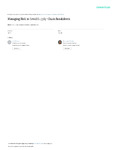Please use this identifier to cite or link to this item:
http://lib.hpu.edu.vn/handle/123456789/35709Full metadata record
| DC Field | Value | Language |
|---|---|---|
| dc.contributor.author | Chopra, Sunil | en_us |
| dc.contributor.author | Sodhi, Manmohan S. | en_us |
| dc.date.accessioned | 2025-04-21T02:13:09Z | |
| dc.date.available | 2025-04-21T02:13:09Z | |
| dc.date.issued | 2004 | en_us |
| dc.identifier.other | HPU2166504 | en_us |
| dc.identifier.uri | https://lib.hpu.edu.vn/handle/123456789/35709 | |
| dc.description.abstract | On March 17, 2000, lightning hit a power line in Albuquerque, New Mexico. The strike caused a massive surge in the surrounding electrical grid, which in turn started a fire at a local plant owned by Royal Philips Electronics, N.V., damaging millions of microchips. Scandinavian mobile-phone manufacturer Nokia Corp., a major customer of the plant, almost immediately began switching its chip orders to other Philips plants, as well as to other Japanese and American suppliers. Thanks to its multiple-supplier strategy and responsiveness, Nokia’s production suffered little during the crisis. | en_us |
| dc.format.extent | 13 p. | en_us |
| dc.format.mimetype | application/pdf | |
| dc.language.iso | en | en_us |
| dc.publisher | MIT Sloan Management Review | en_us |
| dc.subject | Supply Chain Management | en_us |
| dc.subject | Logistics | en_us |
| dc.subject | Managing Risk | en_us |
| dc.title | Managing Risk to Avoid Supply-Chain Breakdown | en_us |
| dc.type | Article | en_us |
| dc.size | 464 KB | en_us |
| dc.department | Sociology | en_us |
| Appears in Collections: | Sociology | |
Files in This Item:
| File | Description | Size | Format | |
|---|---|---|---|---|
| Managing-Risk-to-Avoid-Supply-Chain-Breakdown.pdf Restricted Access | 464.73 kB | Adobe PDF |  View/Open Request a copy |
Items in DSpace are protected by copyright, with all rights reserved, unless otherwise indicated.
